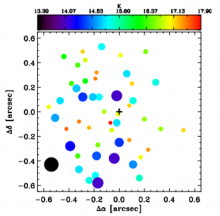
Abstract
Sagittarius A*, the super-massive black hole at the center of the Milky Way, is surrounded by a small cluster of high velocity stars, known as the S-stars. We aim at constraining the amount and nature of the stellar and dark mass associated with the cluster in the immediate vicinity of Sagittarius A*. We use near-infrared imaging to determine the Ks-band luminosity function of the S-star cluster members, and use the distribution of the diffuse background emission and the stellar number density counts around the central black hole. This allows us to determine the stellar light and mass contribution that we can expect from the faint members of the cluster. We then use post-Newtonian N-body techniques to investigate the effect of stellar perturbations on the motion of S2, as a means of detecting the number and masses of the perturbers. We find that the stellar mass derived from the Ks-band luminosity extrapolation is much smaller than the amount of mass that might be present considering the uncertainties in the orbital motion of the star S2. Also the amount of light from the fainter S-cluster members is below the amount of residual light at the position of the S-star cluster after removing the bright cluster members. If the distribution of stars and stellar remnants is strongly enough peaked near Sagittarius A*, observed changes in the orbital elements of S2 can be used to constrain both their masses and numbers. Based on simulations of the cluster of high velocity stars we find that close to the confusion level for 8 m class telescopes blend stars will occur (preferentially near the position of Sagittarius A*) that last for typically 3 years before they dissolve due to proper motions.